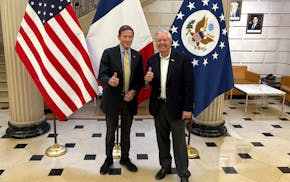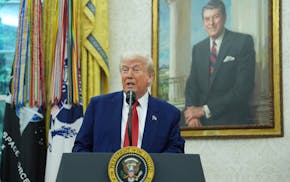Listen and subscribe to our podcast: Apple Podcasts | Spotify
In the summer of 1977, the leaders of a small Iron Range town made a rather bold announcement: Kinney, Minn., had seceded from the United States.
The statement was tongue-in-cheek, but the town's situation wasn't funny. Kinney's leaders had exhausted their options. The town had to come up with $186,000 to repair its water system and it wasn't getting the financial support it needed from the state or federal governments.
What about asking for aid as a foreign country, instead? The idea was hatched at Mary's Bar, the watering hole owned by the town's longtime mayor, Mary Anderson. (Well-equipped with a lively sense of humor, Anderson was not only a politician and a bartender, she was also a nurse.)
In a letter to then-U.S. Secretary of State Cyrus Vance, Anderson and five other Kinney leaders declared they had decided to secede from the United States.
"Be it resolved," they wrote. "Our area is large enough for it. We are 12 square blocks, three blocks wide and four blocks long. We will be similar to Monaco."
The Republic of Kinney was born.
Mary Tennis, director of the St. Louis County Depot, first heard about Kinney's "secession" during Duluth and St. Louis County Days this past February. A history-minded sort, she began sharing what she had learned with others at the event, piquing the curiosity of a Curious Minnesota reporter.
The story of the Republic of Kinney is one of dismissed town needs, a wacky, bar-born plan and the power of media attention. It involves a feisty mayor with an eye toward the limelight, a pizza roll magnate with a spare car, and printed passports logged into a loose-leaf binder.
"It shows the fortitude and ingenuity of a small town in northern Minnesota," Tennis said. "I love that it was a work-around to get voices heard for something really important, but it also had a sense of humor and that the citizens of Kinney doubled down on it."
Taking matters 'into their own hands'
In the heart of the Iron Range, Kinney first cropped up in the early 1900s. It was a mining town built for those who were working nearby to extract newly discovered ore.
By the latter half of the century, the town's infrastructure was taxed. Its water pipes were full of mineral deposits and the pressure was so low that fire hydrants wouldn't work.
"These people in this small town had a problem, went about their traditional channels to get it solved and didn't have much success. So they took matters into their own hands," said Scott Kuzma, who wrote a book called "The Republic of Kinney."
In Kinney leaders' message to Vance, they wrote that "it is much easier to get assistance as a foreign country, which we need badly, and there is no paper work to worry about."
If it was required, they would go to war and lose quickly, they added. None of the local politicians had a lot of spare time for combat.
"Our Mayor works as a nurse in a hospital, and most of our council members work in a nearby mine and cannot get much time off from work," the letter said.
Vance did not respond, according to news reports from the time.
But when Ginny Wennen, a reporter for the Mesabi Daily News, shared the town's story nearly seven months later, it swiftly became a talker.
The Feb. 5, 1978, headline: "A new foreign country? Move over Monaco, here comes Kinney."
Soon, the tale of small-town secession popped up in newspapers around the nation — and got a mention from David Brinkley on the NBC evening news. (Current Kinney Mayor Patrick Haley has a VHS recording of the broadcast, he said.)
The Republic of Kinney started selling numbered passports with its town slogan "filed in triplicate" — a spoof on the bureaucratic red tape they had tried and failed to cut through when requesting funds — written on a shield.
The size of a business card, the passport also had the words "Birthplace of the loon" (a nod to a Kinney politician's role in securing the loon as state bird) and "Heart of the Range" stamped in green ink.
Mary Anderson mailed one to Gov. Rudy Perpich.
She made him an honorary citizen and said the passport was good for a free slice of the Iron Range pastry called potica. He responded with a letter recognizing the Republic of Kinney as a sovereign nation.
Within weeks, newspapers reported that aid was coming in. After learning that Kinney's squad car had broken down, Jeno Paulucci, a Duluth businessman with Iron Range roots, donated a Ford LTD.
It had a "Republic of Kinney" shield on the car door. When Paulucci presented the keys to the mayor, he told Anderson that her city "helped us all throughout the United States who are sick of the bureaucrats and the red tape and the frustrations they cause," according to the Duluth News Tribune.
He also gave 10 cases of his own brand of pizza.
Before the year's end, Kinney had received enough funds from the state's Iron Range Resources and Rehabilitation agency to improve its water system.
The Republic of Kinney had also raised more than $2,000 in T-shirt and passport sales. "We did get a lot of attention from all this, didn't we," Anderson told the Duluth newspaper.
End of an era
Kinney had more than 300 residents when it made its move to secede. These days, there are about 140 people.
Mary's Bar burned down in the mid-1990s. It was rebuilt and later became Liquid Larry's. For a time, people could still buy a "Republic of Kinney" passport there.
Mary Anderson died in 2007, and was described as "colorful and feisty," an "institution," and an "Iron Range matriarch" in her News Tribune obituary.
Liquid Larry's was Kinney's last standing business when it closed and was later razed in 2024.
Current mayor Haley, who has lived in Kinney since 1978, said the town's hangout these days might just be his garage. Haley described Kinney as an island surrounded by mining. U.S. Steel has bought a lot of the town's houses on the north side of its Main Street. Some have been torn down.
The city's library is closed and is set to shift into a space for community events, Haley said. There's a nice playground, though, and for the hundreds who return to Kinney in the summer, the town still has a solid Fourth of July celebration.
With the bar gone, no one comes to town flashing a "Republic of Kinney" passport anymore, Haley said. He wondered aloud: If they did, where would they show it?
Still, card-carrying "Republic of Kinney" fans exist, nearly half a century later. Jamie Hysjulien keeps a passport tucked into her wallet.
"It really speaks to the culture of the Iron Range," said Hysjulien, who was raised in the Twin Cities, but has family ties to the Iron Range. "I think that's why I carry it around, dorkishly. It's part of my family's history and Iron Range history."
She doesn't get a chance to talk about it much.
"On the rare occasion it will come up, I'll take it out of my wallet and tell my story," she said. "It's a fun story to tell people."
If you'd like to submit a Curious Minnesota question, fill out the form below:
Read more Curious Minnesota stories:
The stranger-than-fiction tale of how a real Minnesota island became 'Moosylvania'
How did egg coffee become a Minnesota tradition?
Inside the mines and megamachines of the Iron Range
What did the topography of the Iron Range look like before it was mined?

At least 31 Palestinians are killed while heading to a Gaza aid site, officials and witnesses say

After talks with Zelenskyy and Macron, US senators warn: Putin 'is preparing for more war'

Golden Valley puts police chief on paid leave

Can Trump fix the national debt? Republican senators, many investors and even Elon Musk have doubts


